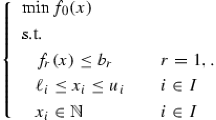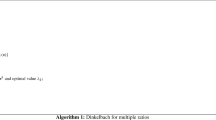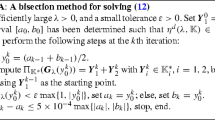Abstract
The paper shows that the global resolution of a general convex quadratic program with complementarity constraints (QPCC), possibly infeasible or unbounded, can be accomplished in finite time. The method constructs a minmax mixed integer formulation by introducing finitely many binary variables, one for each complementarity constraint. Based on the primal-dual relationship of a pair of convex quadratic programs and on a logical Benders scheme, an extreme ray/point generation procedure is developed, which relies on valid satisfiability constraints for the integer program. To improve this scheme, we propose a two-stage approach wherein the first stage solves the mixed integer quadratic program with pre-set upper bounds on the complementarity variables, and the second stage solves the program outside this bounded region by the Benders scheme. We report computational results with our method. We also investigate the addition of a penalty term y T Dw to the objective function, where y and w are the complementary variables and D is a nonnegative diagonal matrix. The matrix D can be chosen effectively by solving a semidefinite program, ensuring that the objective function remains convex. The addition of the penalty term can often reduce the overall runtime by at least 50 %. We report preliminary computational testing on a QP relaxation method which can be used to obtain better lower bounds from infeasible points; this method could be incorporated into a branching scheme. By combining the penalty method and the QP relaxation method, more than 90 % of the gap can be closed for some QPCC problems.






Similar content being viewed by others
References
Bienstock, D.: Eigenvalue techniques for proving bounds for convex objective, nonconvex programs. In: IPCO, vol. 29 (2010)
Candès, E.J., Recht, B.: Exact matrix completion via convex optimization. Found. Comput. Math. 9, 717–772 (2009)
Eaves, B.C.: On quadratic programing. Manag. Sci. 17, 698–711 (1971)
Fazel, M.: Matrix rank minimization with applications. Ph.D. thesis, Electrical Engineering Department, Stanford University (2002)
Fazel, M., Hindi, H., Boyd, S.: Rank minimization and applications in system theory. In: Proceedings of the 2004 American Control Conference, Boston, Massachusetts, 30–July 2, 2004, pp. 3273–3278 (2004)
Han, Z.: A SAT solver implemented in MATLAB http://www.mathworks.com/matlabcentral/fileexchange/22284-satisfiability-solver Accessed September 2011
Hooker, J.N.: Logic-Based Methods for Optimization: Combining Optimization and Constraint Satisfaction. Wiley, New York (2000)
Hooker, J.N.: Integrated Methods for Optimization. Springer, New York (2006)
Hooker, J.N., Ottosson, G.: Logic-based benders decomposition. Math. Program. 96, 33–60 (2003)
Hu, J.: On linear programs with linear complementarity constraints. Ph.D. thesis, Mathematical Sciences, Rensselaer Polytechnic Institute (2009)
Hu, J., Mitchell, J.E., Pang, J.S., Bennett, K.P., Kunapuli, G.: On the global resolution of linear programs with linear complementarity constraints. SIAM J. Optim. 19, 445–471 (2008)
Hu, J., Mitchell, J.E., Pang, J.S.: An LPCC approach to nonconvex quadratic programs. Math. Program. 133, 243–277 (2012)
Hu, J., Mitchell, J.E., Pang, J.S., Yu, B.: On linear programs with linear complementarity constraints. J. Glob. Optim. 53, 29–51 (2012)
Jiang, H., Ralph, D.: QPECgen, a MATLAB generator for mathematical programs with quadratic objectives and affine variational inequality constraints. Comput. Optim. Appl. 13, 25–59 (1999)
KNITRO User’s Manual Version 6.0. http://www.ziena.com/docs/Knitro60_UserManual.pdf. Accessed February 2012
Luo, Z.Q., Pang, J.S., Ralph, D.: Mathematical Programs with Equilibrium Constraints. Cambridge University Press, New York (1996)
MacMPEC Test Problems. http://wiki.mcs.anl.gov/leyffer/index.php/MacMPEC. Accessed September 2011
Mitchell, J.E., Pang, J.S., Yu, B.: Obtaining tighter relaxations of linear programs with complementarity constraints. In: Modeling and Optimization: Theory and Applications. Springer Proceedings in Mathematics and Statistics, vol. 21 (2012)
Pang, J.S.: Three modeling paradigms in mathematical programming. Math. Program. 125, 297–323 (2010)
Toh, K.C., Todd, M.J., Tutuncu, R.H.: SDPT3—a Matlab software package for semidefinite programming. Optim. Methods Softw. 11, 545–581 (1999)
Yu, B.: A branch and cut approach to linear programs with linear complementarity constraints. Ph.D. thesis, Mathematical Sciences, Rensselaer Polytechnic Institute (2011)
Acknowledgements
Our thanks to two anonymous referees for their helpful and constructive comments.
Author information
Authors and Affiliations
Corresponding author
Additional information
The work of Mitchell was supported by the National Science Foundation under grant DMS-0715446 and by the Air Force Office of Sponsored Research under grant FA9550-08-1-0081 and FA9550-11-1-0260. The work of Pang was supported by the U.S.A. National Science Foundation grant CMMI 0969600 and by the Air Force Office of Sponsored Research under grants FA9550-08-1-0061 and FA9550-11-1-0151.
Rights and permissions
About this article
Cite this article
Bai, L., Mitchell, J.E. & Pang, JS. On convex quadratic programs with linear complementarity constraints. Comput Optim Appl 54, 517–554 (2013). https://doi.org/10.1007/s10589-012-9497-4
Received:
Published:
Issue Date:
DOI: https://doi.org/10.1007/s10589-012-9497-4




